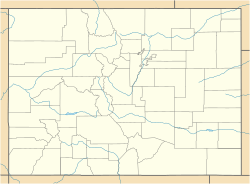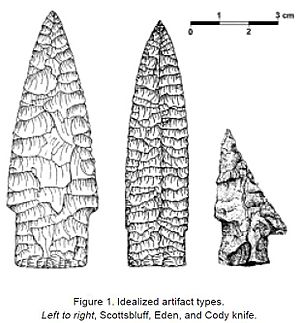Jurgens Site facts for kids
Quick facts for kids |
|
|
Jurgens Site
|
|
| Location | 1 mile (1.6 km) north of Kersey on State Highway 37 |
|---|---|
| Nearest city | Kersey, Colorado |
| Area | 12 acres (4.9 ha) |
| MPS | Prehistoric Paleo-Indian Cultures of the Colorado Plains MPS |
| NRHP reference No. | 90001084 |
| Added to NRHP | July 18, 1990 |
The Jurgens Site is a very old place in Colorado. It's near Greeley in Weld County. Long, long ago, about 7,000 to 7,500 years before Christ (BC), Paleo-Indians lived here. They mostly hunted big animals like ancient bison. But they also collected plants and seeds for food.
Contents
Where is the Jurgens Site Located?
This important site is in northeastern Colorado. It sits on a flat area, called a terrace, near the South Platte River. It's about 9 miles (14 km) east of Greeley, close to the town of Kersey. Two other ancient sites are nearby: the Frazier site is 1 mile (1.6 km) away, and the Dent site is 16 miles (26 km) to the southwest.
Who Lived at the Jurgens Site?
Paleo-Indians and Their Way of Life
Paleo-Indians were early people who lived in North America. They were skilled hunters, especially of large animals. One of their main targets was the Bison antiquus, a huge type of bison that lived long ago.
The time they lived was a period of big change. The Ice Age was ending, and the climate was getting warmer. Melting glaciers created lakes and grassy plains called savannas. This provided good hunting grounds. However, as the land became drier, food became harder to find. People had to adapt. They started hunting smaller animals and gathering wild plants to add to their diet.
The Cody Complex Culture
The tools and items found at the Jurgens Site belong to a group of ancient people called the Cody complex culture. This culture was first identified in 1951 at a bison hunting site near Cody, Wyoming.
Cody complex sites are special because of their unique campsites, tools, and how they butchered animals. Their tools, dating from about 6,000 to 8,000 BC, include special Cody knives and spear points. These spear points are shaped like Scottsbluff and diamond-shaped Eden projectile points. At the Jurgens Site, archaeologists also found tools called shaft abraders. These were used to straighten the shafts of spears.
Experts believe that people from the Agate Basin Site culture lived at the Jurgens Site first. Later, another group, sometimes called the "Kersey culture," lived there too.
Hunting Ancient Bison
Even though the Bison antiquus were slowly disappearing due to climate changes at the end of the Ice Age, the Jurgens Site shows how good these ancient people were at hunting. Around 7150 BC, they were able to catch many bison at this location.
What Did Archaeologists Find?
Discovering Ancient Artifacts
Archaeologists found different kinds of artifacts in specific areas at the Jurgens Site. These findings help us understand how the Paleo-Indians lived and worked.
| Area Found | What Was Found |
|---|---|
| Butcher station | Many bison bones, but not the heavy skulls or hip bones. Also, tools used for killing and cutting up animals. |
| Short-term camp | A few items for preparing animal hides, making tools, and daily living activities. |
| Residential area | More items for hide preparation, a special area and stone slab for grinding seeds and plants, and clear signs of tool making and daily life. |
There was also a spot where tools were sharpened or replaced. Besides bison bones, archaeologists found bones from other animals like antelope, elk, deer, fish, and birds. This shows they hunted a variety of creatures.
Tools Used by Paleo-Indians
The tools found at the Jurgens Site tell us a lot about the people who lived there. Here are some examples:
- 63 Kersey lanceolate projectile points: These spear points were similar to Eden projectile points. They were made from local quartzite rock and also from Alibates flint, which came all the way from northern Texas.
- 271 utilized and 2,023 debitage flakes: These are small pieces of stone that broke off when tools were being made or sharpened.
- 84 end scrapers: Tools likely used for scraping animal hides clean.
- 32 knives: Some of these knives seem to have been made from older spear points.
- 30 ground-stone tools: These include tools like anvils (for hammering on) and hammerstones (for hitting).
- 9 bone tools: Such as atlatl hooks (used with spear-throwers), an engraved bone tool called an unla, and an antler flaking hammer.
- 55 stone or mineral items: Various other rocks and minerals used for different purposes.
How the Site Was Studied
The Jurgens Site has been studied by many experts over the years. Their work helps us learn about this ancient place.
| Year | Who Studied It | What They Found or Did |
|---|---|---|
| 1965 | Frank Frazier, a geologist | Frazier discovered the site while studying gravel near the South Platte River. |
| 1968, 1970 | Joe Ben Wheat and Mary Wormington from the University of Colorado Museum. Harold Malde from the United States Geological Survey. This was part of a National Science Foundation project. | They found that the site was used for both hunting and as a campsite. They identified the artifacts as belonging to the Cody complex culture. |
In 1967, Mary Wormington also dug at the Frazier site nearby. There, she found artifacts and bison bones from the Agate Basin Site culture. Harold Malde, the geologist, also worked on the Dent and Frazier sites.




